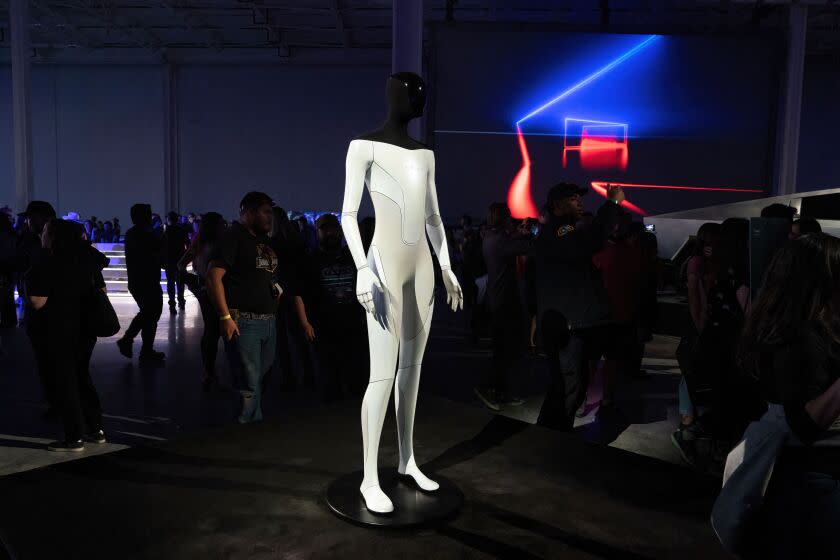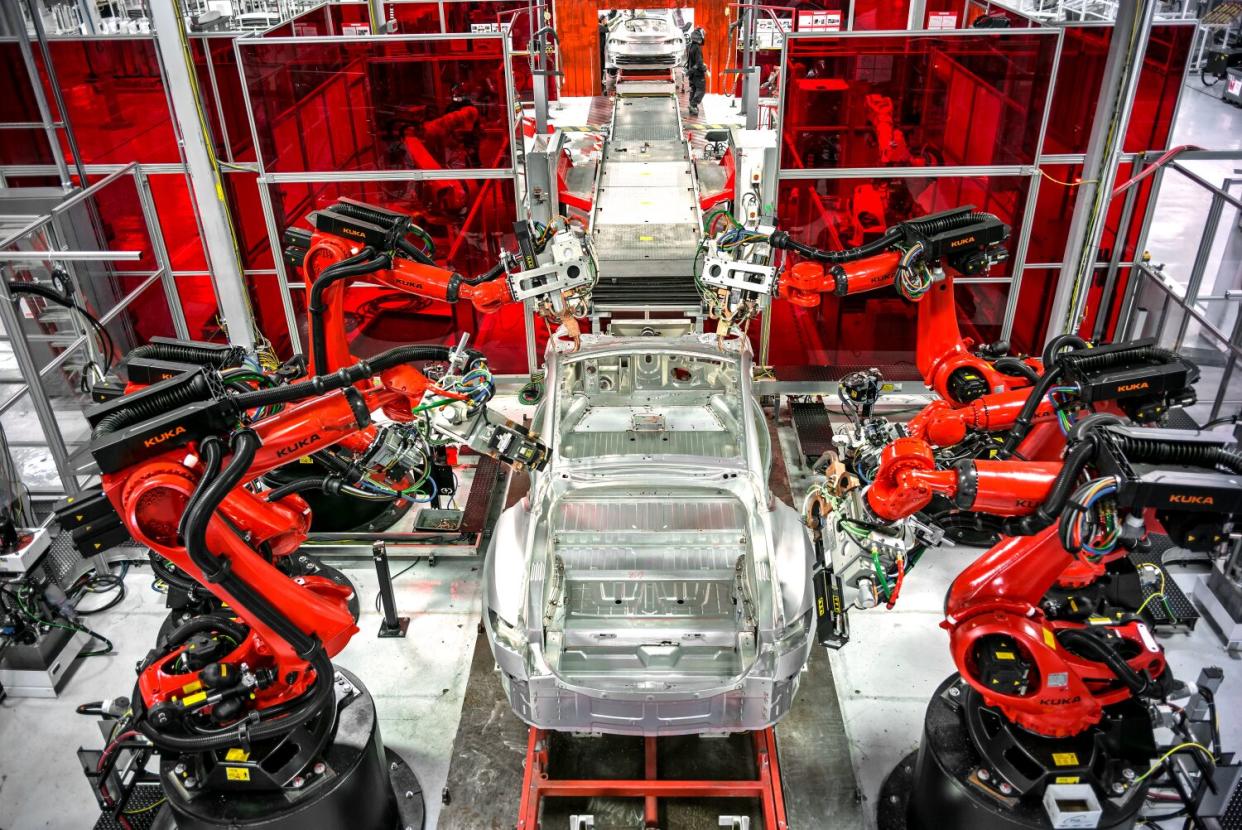Will Elon Musk's Tesla Bot replace human workers? Don't bet on it

Elon Musk is bullish on robots — his own, at least.
The Tesla chief executive claimed last year that his company was in the advanced stages of developing an autonomous android that would relieve humans of their hazardous, repetitive and boring jobs. Some of those humans currently work in Tesla factories, where the company plans to deploy thousands of the new robot, dubbed Tesla Bot or Optimus, according to a recent job listing.
And while Musk has warned that intelligent machines may at some point rebel against humanity à la "The Terminator," Tesla's version will be "friendly," he promised.
On Friday, the world may see just how friendly. At the company's AI Day event, held to showcase its progress in artificial intelligence, Musk reportedly plans to unveil a working prototype of the robot.
It was at last year's AI Day that Musk first discussed the project, saying that the android would be about 5 feet 8, weigh 125 pounds and have a carrying capacity of 45 pounds. Utilizing the same autonomous driving systems as the company's vehicles, the robots, he said, would eventually be capable of such tasks as going to the store to purchase a set list of groceries.
"In the future, physical work will be a choice," he said. "If you want to do it, you can. But you won't need to do it."
And if you're currently hiring people to do physical work, you won't need to do that either.
But there are plenty of reasons to be skeptical of the scenario Musk paints, above and beyond his long history of promising new technologies that arrive years late, if ever. Automation, although an increasingly powerful force in many industries, is not the silver bullet Musk has portrayed it as. And to the extent he is counting on androids such as Optimus to solve his own workforce problems, he's likely to be disappointed.
Technologically speaking, a factory filled with humanoid robots instead of actual humans is at least a decade away, if not more.
"In theory, if we had a humanoid robot that could do basically anything a person could do, that would have a dramatic impact on employment," said Martin Ford, a futurist and author of "Rule of the Robots: How Artificial Intelligence Will Transform Everything."
"We’re very far away from that."
Tesla famously encountered automation-related production difficulties when it rolled out its Model 3 sedan several years ago. Musk has long espoused the benefits of factory automation to produce high volumes of vehicles, even referring to his ideal, AI-laden, robot-powered factory as the "alien dreadnought."
But the technology didn't quite work as planned, leading to bottlenecks on the Model 3 production line. Tesla ended up establishing a factory line under a tent in the parking lot of its Fremont, Calif., factory that went light on automation in favor of manual labor. “Humans are underrated,” Musk tweeted at the time.
"If the robots could do what the people are doing, Musk would get rid of those people and put robots there," Ford said. "He’s always been very, very gung-ho on automation, to some extent, maybe getting a little ahead of the curve there."
Automation across job sectors has been going on for hundreds of years. Agriculture, manufacturing and even financial services have become increasingly automated. The auto industry has been at the forefront of this advancement, particularly in rote or repetitive activities, such as putting doors on cars or lifting parts. Tesla's Fremont factory is no exception.
Thus far, however, these robots look more akin to large, hyper-articulated industrial arms, rather than bipedal, C-3PO types.
"The basis of the U.S. auto industry surviving in its current resurgence is this heavy automation," said Mark Muro, a senior fellow at the Brookings Institution think tank.

A robot that can move around like a human or have similar hand-eye coordination to manipulate items, however, is "still pretty far in the future,” said Ford, the author.
And since the repetitive tasks are already being done by robots, it's unclear why making additional robots shaped like people would be more beneficial.
A Musk spokesperson did not respond to a request for comment about how the Tesla Bot would fit into the vehicle production line, why it is needed and how adoption of the bot could affect the workforce.
One clear advantage robots have over humans, from a business owner's standpoint, is they don't complain about long hours or in-person work, toxic chemical exposure, high injury rates, open racism or other adverse workplace conditions. And they certainly don't form unions to agitate for better ones.
Musk and Tesla have had a contentious relationship with organized labor.
Last year, the National Labor Relations Board ruled that Musk violated labor laws when he mused in a tweet that employees might have to give up stock options if they unionized. This year, the NLRB ruled that Tesla violated workers' rights by preventing them from wearing pro-union T-shirts at work.
Unions have often fought the introduction of robots in workplaces. But automation doesn't have to spell doom for workers.
With a more robust social services net, greater numbers of high-quality jobs across the economy and a comprehensive plan for transitioning automated-out workers to new job, automation can be a good thing for the economy in the long run, said Josh Bivens, research director at the Economic Policy Institute.
"Automation is mostly opportunity," he said. "It's opportunity we need to manage better than we have, but I think blaming it for problems in inequality ... really takes the blame off where it should be," which is on concrete policy decisions that were the actual drivers, he said.
And to truly reach maximum productivity, companies often need to get buy-in from their workforce — and give workers the room and time to become higher-skilled.
"Some firms view robots simply as a way to replace people," Muro said. "But there may be a more productive route in which automation functions as a complement to human workers."
In some cases, unions have collaborated with companies to negotiate new roles for workers and give them a say in how automation plays out.
While advancing automation can curb or decrease union activity, collaboration between a company's workforce and management is necessary for it to all work.
"It requires certain levels of cooperation," said Kalle Lyytinen, professor of design and innovation at Case Western Reserve University. "It's as important to invest in ... the social, organizational and human skills in managing and coordinating and leveraging these new types of technologies.”
Times staff writer Russ Mitchell contributed to this report.
This story originally appeared in Los Angeles Times.
